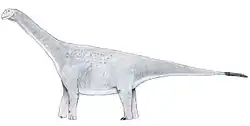| Zigongosaurus Temporal range: Middle Jurassic-Late Jurassic | |
|---|---|
| Scientific classification | |
| Domain: | Eukaryota |
| Kingdom: | Animalia |
| Phylum: | Chordata |
| Clade: | Dinosauria |
| Clade: | Saurischia |
| Clade: | †Sauropodomorpha |
| Clade: | †Sauropoda |
| Family: | †Mamenchisauridae |
| Genus: | †Zigongosaurus Hou, Zhao, & Chao, 1976 |
| Species: | †Z. fuxiensis |
| Binomial name | |
| †Zigongosaurus fuxiensis Hou, Zhao, & Chao, 1976 | |
| Synonyms | |
| |
Zigongosaurus (meaning "Zigong lizard") is a genus of sauropod dinosaur from the Middle Jurassic-Late Jurassic-age Shaximiao Formation of Zigong, Sichuan, China. Because of incomplete knowledge of Jurassic Chinese sauropods, it has been hard to interpret, with some sources assigning it to Omeisaurus, some to Mamenchisaurus, and some to its own genus.
History and taxonomy
The genus was based on CV 02501,[1] a specimen including a partial mandible, maxilla, and basioccipital (a bone from the braincase region). Additional bones from all areas of the skeleton, belonging to multiple individuals, were also described and assigned to the new genus. The authors thought it resembled Omeisaurus, but was distinct based on vertebral details.[2] Early accounts in the popular press suggested it was a brachiosaurid.[3][4][5]
Chinese sauropod taxonomy became increasingly convoluted in the 1980s. In 1983, Dong, Zhou, and Zhang named a species Omeisaurus fuxiensis, which they based on different material than Zigongosaurus fuxiensis, but then suggested that the two were the same animal.[6] Following this, the genus was thought to belong to Omeisaurus,[7] possibly as a synonym of O. junghsiensis.[8] In the mid-1990s, opinion shifted, and the genus was instead assigned, by Zhang and Chen, to Mamenchisaurus. They noted that it came from a stratigraphic level between the usual Omeisaurus and Mamenchisaurus beds in age, but more closely resembled Mamenchisaurus. In particular, the neural spines of the vertebrae (the part of the vertebra that sticks up, over the passage for the spinal cord) in both genera have distinctive weak bifurcation, or splitting, that is not found in Omeisaurus. The authors renamed it Mamenchisaurus fuxiensis.[9] This assignment was followed provisionally in the most recent major review of sauropods,[10] but at least one author (Valérie Martin-Rolland) has found it to be a distinct genus.[11]
Paleobiology
Whichever genus it turns out to be, as a mamenchisaur- or omeisaur-like sauropod it would have been a large, quadrupedal herbivore with a long neck.[10] It is regarded as a medium- to large-sized sauropod,[9] with a length of around 15 meters (50 feet).[12]
References
- ↑ Peng, G.Z.; Ye, Y.; Gao, Y.H.; Shu, C.K.; Jiang, S. (2005). "Jurassic dinosaur faunas in Zigong". Zigong Dinosaur Museum, Zigong.
- ↑ Hou, L.-h.; Zhou, S.-w.; Chao, S.-c. (1976). "New discovery of sauropod dinosaurs from Sichuan". Vertebrata PalAsiatica (in Chinese). 14 (3): 160–165.
- ↑ Glut, Donald F. (1982). The New Dinosaur Dictionary. Secaucus, NJ: Citadel Press. p. 263. ISBN 0-8065-0782-9.
- ↑ Lambert, David; the Diagram Group (1983). A Field Guide to Dinosaurs. New York: Avon Books. p. 119. ISBN 0-380-83519-3.
- ↑ Norman, David. B. (1985). "Camarasaurids & Brachiosaurids". The Illustrated Encyclopedia of Dinosaurs: An Original and Compelling Insight into Life in the Dinosaur Kingdom. New York: Crescent Books. pp. 86–91. ISBN 0-517-46890-5.
- ↑ Zhiming, Dong; Zhou, S.; Zhang, H. (1983). "Dinosaurs from the Jurassic of Sichuan". Palaeontologia Sinica, New Series C (in Chinese). 162 (33): 1–136.
- ↑ Lambert, David; the Diagram Group (1990). The Dinosaur Data Book. New York: Avon Books. p. 105. ISBN 0-380-75896-2.
- ↑ McIntosh, Jack S. (1990). "Sauropoda". In Weishampel, David B.; Dodson, Peter; Osmólska, Halszka (eds.). The Dinosauria. Berkeley: University of California Press. pp. 345–401. ISBN 0-520-06727-4.
- 1 2 Zhang, Y.; Chen, W. (1996). "Preliminary research on the classification of sauropods from Sichuan Basin, China". In Morales, M. (ed.). The Continental Jurassic. Museum of Northern Arizona Bulletin, 60. Museum of Northern Arizona. pp. 97–107.
- 1 2 Upchurch, Paul; Barrett, Paul M.; Dodson, Peter (2004). "Sauropoda". In Weishampel, David B.; Dodson, Peter; Osmólska, Halszka (eds.). The Dinosauria (2nd ed.). Berkeley: University of California Press. pp. 259–322. ISBN 0-520-24209-2.
- ↑ Martin-Rolland, Valérie (1999). "Les sauropodes chinois". Revue Paléobiologie, Genève (in French). 18 (1): 287–315.
- ↑ Lessem, D. & Glut, D.F. (1993). "Omeisaurus". The Dinosaur Society Dinosaur Encyclopedia. Random House. pp. 329–330. ISBN 0-679-41770-2.










